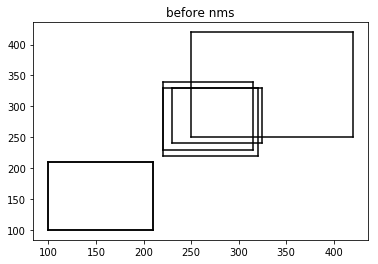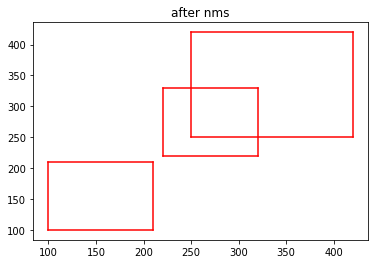您好,登錄后才能下訂單哦!
您好,登錄后才能下訂單哦!
這篇文章主要介紹“Python非極大值抑制的實現方法有哪些”,在日常操作中,相信很多人在Python非極大值抑制的實現方法有哪些問題上存在疑惑,小編查閱了各式資料,整理出簡單好用的操作方法,希望對大家解答”Python非極大值抑制的實現方法有哪些”的疑惑有所幫助!接下來,請跟著小編一起來學習吧!
Cython是一個快速生成Python擴展模塊的工具,從語法層面上來講是Python語法和C語言語法的混血,當Python性能遇到瓶頸時,Cython直接將C的原生速度植入Python程序,這樣使Python程序無需使用C重寫,能快速整合原有的Python程序,這樣使得開發效率和執行效率都有很大的提高,而這些中間的部分,都是Cython幫我們做了。
Faster-RCNN中有兩處使用NMS,第一處是訓練+預測的時候,利用ProposalCreator來生成proposal的時候,因為只需要一部分proposal,所以利用NMS進行篩選。第二處使用是預測的時候,當得到300個分類與坐標偏移結果的時候,需要對每個類別逐一進行非極大值抑制。也許有人問為什么對于每個類別不直接取置信度最高的那一個?因為一張圖中某個類別可能不止一個,例如一張圖中有多個人,直接取最高置信度的只能預測其中的一個人,而通過NMS理想情況下可以使得每個人(每類中的每個個體)都會有且僅有一個bbox框。
#!/usr/bin/env python3
# -*- coding: utf-8 -*-
"""
Created on Mon May 7 21:45:37 2018
@author: lps
"""
import numpy as np
boxes=np.array([[100,100,210,210,0.72],
[250,250,420,420,0.8],
[220,220,320,330,0.92],
[100,100,210,210,0.72],
[230,240,325,330,0.81],
[220,230,315,340,0.9]])
def py_cpu_nms(dets, thresh):
# dets:(m,5) thresh:scaler
x1 = dets[:,0]
y1 = dets[:,1]
x2 = dets[:,2]
y2 = dets[:,3]
areas = (y2-y1+1) * (x2-x1+1)
scores = dets[:,4]
keep = []
index = scores.argsort()[::-1]
while index.size >0:
i = index[0] # every time the first is the biggst, and add it directly
keep.append(i)
x11 = np.maximum(x1[i], x1[index[1:]]) # calculate the points of overlap
y11 = np.maximum(y1[i], y1[index[1:]])
x22 = np.minimum(x2[i], x2[index[1:]])
y22 = np.minimum(y2[i], y2[index[1:]])
w = np.maximum(0, x22-x11+1) # the weights of overlap
h = np.maximum(0, y22-y11+1) # the height of overlap
overlaps = w*h
ious = overlaps / (areas[i]+areas[index[1:]] - overlaps)
idx = np.where(ious<=thresh)[0]
index = index[idx+1] # because index start from 1
return keep
import matplotlib.pyplot as plt
def plot_bbox(dets, c='k'):
x1 = dets[:,0]
y1 = dets[:,1]
x2 = dets[:,2]
y2 = dets[:,3]
plt.plot([x1,x2], [y1,y1], c)
plt.plot([x1,x1], [y1,y2], c)
plt.plot([x1,x2], [y2,y2], c)
plt.plot([x2,x2], [y1,y2], c)
plt.title("after nms")
plot_bbox(boxes,'k') # before nms
keep = py_cpu_nms(boxes, thresh=0.7)
plot_bbox(boxes[keep], 'r')# after nms結果大致這樣:


新建nms文件夾,將nms_py.py 和__init__.py(空)文件放在其內成為包,可以調用。然后在nms文件夾外新建測試運行時間腳本 test_num.py:
import numpy as np
import time
from nms.nums_py import py_cpu_nms # for cpu
#from nms.gpu_nms import gpu_nms # for gpu
np.random.seed( 1 ) # keep fixed
num_rois = 6000
minxy = np.random.randint(50,145,size=(num_rois ,2))
maxxy = np.random.randint(150,200,size=(num_rois ,2))
score = 0.8*np.random.random_sample((num_rois ,1))+0.2
boxes_new = np.concatenate((minxy,maxxy,score), axis=1).astype(np.float32)
def nms_test_time(boxes_new):
thresh = [0.7,0.8,0.9]
T = 50
for i in range(len(thresh)):
since = time.time()
for t in range(T):
keep = py_cpu_nms(boxes_new, thresh=thresh[i]) # for cpu
# keep = gpu_nms(boxes_new, thresh=thresh[i]) # for gpu
print("thresh={:.1f}, time wastes:{:.4f}".format(thresh[i], (time.time()-since)/T))
return keep
if __name__ =="__main__":
nms_test_time(boxes_new)測試數據為6000個初始的rois,并設置nms閾值為0.7~0.9。閾值越大越慢,因為滿足小于閾值的roi越多,需要循環的次數也越多。對每個閾值循環執行NMS 50次求平均:
直接運行得到運行時間:
thresh=0.7, time wastes:0.0287
thresh=0.8, time wastes:0.1057
thresh=0.9, time wastes:0.4204
首先復制一份nms_py.py并重命名為nms_py1.pyx,pyx即為Cython文件。然后在nms文件夾下新建setup1.py:
from distutils.core import setup
from Cython.Build import cythonize
setup(
name = 'nms_module',
ext_modules = cythonize('nums_py1.pyx'),
)下面開始生成動態鏈接庫:在終端執行:
python3 setup1.py build
然后在當前目錄會生成nums_py1.c,即C源代碼,然后在nms/build/lib.linux-x86_64-3.5下會生成nums_py1.cpython-35m-x86_64-linux-gnu.so這一動態鏈接庫,將其復制一份至nms文件夾下,則現在可以在測試腳本中進行測試了:只需將測試腳本中的 from nms.nums_py import py_cpu_nms 改為 from nms.nums1_py import py_cpu_nms 即可。因為pyx是不可以直接執行的,只有build完成后才可以。
運行測試腳本得到以下結果:
thresh=0.7, time wastes:0.0272
thresh=0.8, time wastes:0.1038
thresh=0.9, time wastes:0.4184
發現與純python速度相比僅有微小提升,下面再利用第3種方法。
import numpy as np cimport numpy as np # #boxes=np.array([[100,100,210,210,0.72], # [250,250,420,420,0.8], # [220,220,320,330,0.92], # [100,100,210,210,0.72], # [230,240,325,330,0.81], # [220,230,315,340,0.9]]) # cdef inline np.float32_t max(np.float32_t a, np.float32_t b): return a if a >= b else b cdef inline np.float32_t min(np.float32_t a, np.float32_t b): return a if a <= b else b def py_cpu_nms(np.ndarray[np.float32_t,ndim=2] dets, np.float thresh): # dets:(m,5) thresh:scaler cdef np.ndarray[np.float32_t, ndim=1] x1 = dets[:,0] cdef np.ndarray[np.float32_t, ndim=1] y1 = dets[:,1] cdef np.ndarray[np.float32_t, ndim=1] x2 = dets[:,2] cdef np.ndarray[np.float32_t, ndim=1] y2 = dets[:,3] cdef np.ndarray[np.float32_t, ndim=1] scores = dets[:, 4] cdef np.ndarray[np.float32_t, ndim=1] areas = (y2-y1+1) * (x2-x1+1) cdef np.ndarray[np.int_t, ndim=1] index = scores.argsort()[::-1] # can be rewriten keep = [] cdef int ndets = dets.shape[0] cdef np.ndarray[np.int_t, ndim=1] suppressed = np.zeros(ndets, dtype=np.int) cdef int _i, _j cdef int i, j cdef np.float32_t ix1, iy1, ix2, iy2, iarea cdef np.float32_t w, h cdef np.float32_t overlap, ious j=0 for _i in range(ndets): i = index[_i] if suppressed[i] == 1: continue keep.append(i) ix1 = x1[i] iy1 = y1[i] ix2 = x2[i] iy2 = y2[i] iarea = areas[i] for _j in range(_i+1, ndets): j = index[_j] if suppressed[j] == 1: continue xx1 = max(ix1, x1[j]) yy1 = max(iy1, y1[j]) xx2 = max(ix2, x2[j]) yy2 = max(iy2, y2[j]) w = max(0.0, xx2-xx1+1) h = max(0.0, yy2-yy1+1) overlap = w*h ious = overlap / (iarea + areas[j] - overlap) if ious>thresh: suppressed[j] = 1 return keep import matplotlib.pyplot as plt def plot_bbox(dets, c='k'): x1 = dets[:,0] y1 = dets[:,1] x2 = dets[:,2] y2 = dets[:,3] plt.plot([x1,x2], [y1,y1], c) plt.plot([x1,x1], [y1,y2], c) plt.plot([x1,x2], [y2,y2], c) plt.plot([x2,x2], [y1,y2], c)
其中變量靜態類型可以極大的提高效率,原因是參與計算的主要是變量,主要的變化是將變量利用cdef定義。
然后同上建立setup2.py:
from distutils.core import setup
from Cython.Build import cythonize
setup(
name = 'nms_module',
ext_modules = cythonize('nums_py2.pyx'),
)build后將動態庫.so拷貝到nms文件夾下,然后同上修改測試腳本,執行測試腳本:
thresh=0.7, time wastes:0.0019
thresh=0.8, time wastes:0.0028
thresh=0.9, time wastes:0.0036
發現速度相較于純python分別提升了15倍、38倍、118倍!
import numpy as np cimport numpy as np assert sizeof(int) == sizeof(np.int32_t) cdef extern from "gpu_nms.hpp": void _nms(np.int32_t*, int*, np.float32_t*, int, int, float, int) def gpu_nms(np.ndarray[np.float32_t, ndim=2] dets, np.float thresh, np.int32_t device_id=0): cdef int boxes_num = dets.shape[0] cdef int boxes_dim = dets.shape[1] cdef int num_out cdef np.ndarray[np.int32_t, ndim=1] \ keep = np.zeros(boxes_num, dtype=np.int32) cdef np.ndarray[np.float32_t, ndim=1] \ scores = dets[:, 4] cdef np.ndarray[np.int_t, ndim=1] \ order = scores.argsort()[::-1] cdef np.ndarray[np.float32_t, ndim=2] \ sorted_dets = dets[order, :] _nms(&keep[0], &num_out, &sorted_dets[0, 0], boxes_num, boxes_dim, thresh, device_id) keep = keep[:num_out] return list(order[keep])
再建立文件nms_gpu.hpp:
void _nms(int* keep_out, int* num_out, const float* boxes_host, int boxes_num, int boxes_dim, float nms_overlap_thresh, int device_id);
和nms_kernel.cu文件:
#include "gpu_nms.hpp"
#include <vector>
#include <iostream>
#define CUDA_CHECK(condition) \
/* Code block avoids redefinition of cudaError_t error */ \
do { \
cudaError_t error = condition; \
if (error != cudaSuccess) { \
std::cout << cudaGetErrorString(error) << std::endl; \
} \
} while (0)
#define DIVUP(m,n) ((m) / (n) + ((m) % (n) > 0))
int const threadsPerBlock = sizeof(unsigned long long) * 8;
__device__ inline float devIoU(float const * const a, float const * const b) {
float left = max(a[0], b[0]), right = min(a[2], b[2]);
float top = max(a[1], b[1]), bottom = min(a[3], b[3]);
float width = max(right - left + 1, 0.f), height = max(bottom - top + 1, 0.f);
float interS = width * height;
float Sa = (a[2] - a[0] + 1) * (a[3] - a[1] + 1);
float Sb = (b[2] - b[0] + 1) * (b[3] - b[1] + 1);
return interS / (Sa + Sb - interS);
}
__global__ void nms_kernel(const int n_boxes, const float nms_overlap_thresh,
const float *dev_boxes, unsigned long long *dev_mask) {
const int row_start = blockIdx.y;
const int col_start = blockIdx.x;
// if (row_start > col_start) return;
const int row_size =
min(n_boxes - row_start * threadsPerBlock, threadsPerBlock);
const int col_size =
min(n_boxes - col_start * threadsPerBlock, threadsPerBlock);
__shared__ float block_boxes[threadsPerBlock * 5];
if (threadIdx.x < col_size) {
block_boxes[threadIdx.x * 5 + 0] =
dev_boxes[(threadsPerBlock * col_start + threadIdx.x) * 5 + 0];
block_boxes[threadIdx.x * 5 + 1] =
dev_boxes[(threadsPerBlock * col_start + threadIdx.x) * 5 + 1];
block_boxes[threadIdx.x * 5 + 2] =
dev_boxes[(threadsPerBlock * col_start + threadIdx.x) * 5 + 2];
block_boxes[threadIdx.x * 5 + 3] =
dev_boxes[(threadsPerBlock * col_start + threadIdx.x) * 5 + 3];
block_boxes[threadIdx.x * 5 + 4] =
dev_boxes[(threadsPerBlock * col_start + threadIdx.x) * 5 + 4];
}
__syncthreads();
if (threadIdx.x < row_size) {
const int cur_box_idx = threadsPerBlock * row_start + threadIdx.x;
const float *cur_box = dev_boxes + cur_box_idx * 5;
int i = 0;
unsigned long long t = 0;
int start = 0;
if (row_start == col_start) {
start = threadIdx.x + 1;
}
for (i = start; i < col_size; i++) {
if (devIoU(cur_box, block_boxes + i * 5) > nms_overlap_thresh) {
t |= 1ULL << i;
}
}
const int col_blocks = DIVUP(n_boxes, threadsPerBlock);
dev_mask[cur_box_idx * col_blocks + col_start] = t;
}
}
void _set_device(int device_id) {
int current_device;
CUDA_CHECK(cudaGetDevice(¤t_device));
if (current_device == device_id) {
return;
}
// The call to cudaSetDevice must come before any calls to Get, which
// may perform initialization using the GPU.
CUDA_CHECK(cudaSetDevice(device_id));
}
void _nms(int* keep_out, int* num_out, const float* boxes_host, int boxes_num,
int boxes_dim, float nms_overlap_thresh, int device_id) {
_set_device(device_id);
float* boxes_dev = NULL;
unsigned long long* mask_dev = NULL;
const int col_blocks = DIVUP(boxes_num, threadsPerBlock);
CUDA_CHECK(cudaMalloc(&boxes_dev,
boxes_num * boxes_dim * sizeof(float)));
CUDA_CHECK(cudaMemcpy(boxes_dev,
boxes_host,
boxes_num * boxes_dim * sizeof(float),
cudaMemcpyHostToDevice));
CUDA_CHECK(cudaMalloc(&mask_dev,
boxes_num * col_blocks * sizeof(unsigned long long)));
dim3 blocks(DIVUP(boxes_num, threadsPerBlock),
DIVUP(boxes_num, threadsPerBlock));
dim3 threads(threadsPerBlock);
nms_kernel<<<blocks, threads>>>(boxes_num,
nms_overlap_thresh,
boxes_dev,
mask_dev);
std::vector<unsigned long long> mask_host(boxes_num * col_blocks);
CUDA_CHECK(cudaMemcpy(&mask_host[0],
mask_dev,
sizeof(unsigned long long) * boxes_num * col_blocks,
cudaMemcpyDeviceToHost));
std::vector<unsigned long long> remv(col_blocks);
memset(&remv[0], 0, sizeof(unsigned long long) * col_blocks);
int num_to_keep = 0;
for (int i = 0; i < boxes_num; i++) {
int nblock = i / threadsPerBlock;
int inblock = i % threadsPerBlock;
if (!(remv[nblock] & (1ULL << inblock))) {
keep_out[num_to_keep++] = i;
unsigned long long *p = &mask_host[0] + i * col_blocks;
for (int j = nblock; j < col_blocks; j++) {
remv[j] |= p[j];
}
}
}
*num_out = num_to_keep;
CUDA_CHECK(cudaFree(boxes_dev));
CUDA_CHECK(cudaFree(mask_dev));
}然后在nms文件夾外建立setup3.py:
from distutils.core import setup
from Cython.Build import cythonize
from distutils.extension import Extension
from Cython.Distutils import build_ext
import subprocess
import numpy as np
import os
from os.path import join as pjoin
def find_in_path(name, path):
"Find a file in a search path"
# Adapted fom
# http://code.activestate.com/recipes/52224-find-a-file-given-a-search-path/
for dir in path.split(os.pathsep):
binpath = pjoin(dir, name)
if os.path.exists(binpath):
return os.path.abspath(binpath)
return None
def locate_cuda():
"""Locate the CUDA environment on the system
Returns a dict with keys 'home', 'nvcc', 'include', and 'lib64'
and values giving the absolute path to each directory.
Starts by looking for the CUDAHOME env variable. If not found, everything
is based on finding 'nvcc' in the PATH.
"""
# first check if the CUDAHOME env variable is in use
if 'CUDAHOME' in os.environ:
home = os.environ['CUDAHOME']
nvcc = pjoin(home, 'bin', 'nvcc')
else:
# otherwise, search the PATH for NVCC
default_path = pjoin(os.sep, 'usr', 'local', 'cuda', 'bin')
nvcc = find_in_path('nvcc', os.environ['PATH'] + os.pathsep + default_path)
if nvcc is None:
raise EnvironmentError('The nvcc binary could not be '
'located in your $PATH. Either add it to your path, or set $CUDAHOME')
home = os.path.dirname(os.path.dirname(nvcc))
cudaconfig = {'home':home, 'nvcc':nvcc,
'include': pjoin(home, 'include'),
'lib64': pjoin(home, 'lib64')}
for k, v in cudaconfig.items():
if not os.path.exists(v):
raise EnvironmentError('The CUDA %s path could not be located in %s' % (k, v))
return cudaconfig
CUDA = locate_cuda()
try:
numpy_include = np.get_include()
except AttributeError:
numpy_include = np.get_numpy_include()
def customize_compiler_for_nvcc(self):
"""inject deep into distutils to customize how the dispatch
to gcc/nvcc works.
If you subclass UnixCCompiler, it's not trivial to get your subclass
injected in, and still have the right customizations (i.e.
distutils.sysconfig.customize_compiler) run on it. So instead of going
the OO route, I have this. Note, it's kindof like a wierd functional
subclassing going on."""
# tell the compiler it can processes .cu
self.src_extensions.append('.cu')
# save references to the default compiler_so and _comple methods
default_compiler_so = self.compiler_so
super = self._compile
# now redefine the _compile method. This gets executed for each
# object but distutils doesn't have the ability to change compilers
# based on source extension: we add it.
def _compile(obj, src, ext, cc_args, extra_postargs, pp_opts):
if os.path.splitext(src)[1] == '.cu':
# use the cuda for .cu files
self.set_executable('compiler_so', CUDA['nvcc'])
# use only a subset of the extra_postargs, which are 1-1 translated
# from the extra_compile_args in the Extension class
postargs = extra_postargs['nvcc']
else:
postargs = extra_postargs['gcc']
super(obj, src, ext, cc_args, postargs, pp_opts)
# reset the default compiler_so, which we might have changed for cuda
self.compiler_so = default_compiler_so
# inject our redefined _compile method into the class
self._compile = _compile
# run the customize_compiler
class custom_build_ext(build_ext):
def build_extensions(self):
customize_compiler_for_nvcc(self.compiler)
build_ext.build_extensions(self)
ext_modules = [Extension('nms.gpu_nms',
['nms/nms_kernel.cu', 'nms/gpu_nms.pyx'],
library_dirs=[CUDA['lib64']],
libraries=['cudart'],
language='c++',
runtime_library_dirs=[CUDA['lib64']],
# this syntax is specific to this build system
# we're only going to use certain compiler args with nvcc and not with
# gcc the implementation of this trick is in customize_compiler() below
extra_compile_args={'gcc': ["-Wno-unused-function"],
'nvcc': ['-arch=sm_35',
'--ptxas-options=-v',
'-c',
'--compiler-options',
"'-fPIC'"]},
include_dirs = [numpy_include, CUDA['include']]
)]
setup(
name='fast_rcnn',
ext_modules=ext_modules,
# inject our custom trigger
cmdclass={'build_ext': custom_build_ext},
)然后同上修改測試腳本,執行測試腳本:
import numpy as np
import time
#from nms.nums_py2 import py_cpu_nms # for cpu
from nms.gpu_nms import gpu_nms # for gpu
np.random.seed( 1 ) # keep fixed
num_rois = 6000
minxy = np.random.randint(50,145,size=(num_rois ,2))
maxxy = np.random.randint(150,200,size=(num_rois ,2))
score = 0.8*np.random.random_sample((num_rois ,1))+0.2
boxes_new = np.concatenate((minxy,maxxy,score), axis=1).astype(np.float32)
def nms_test_time(boxes_new):
thresh = [0.7,0.8,0.9]
T = 50
for i in range(len(thresh)):
since = time.time()
for t in range(T):
# keep = py_cpu_nms(boxes_new, thresh=thresh[i]) # for cpu
keep = gpu_nms(boxes_new, thresh=thresh[i]) # for gpu
print("thresh={:.1f}, time wastes:{:.4f}".format(thresh[i], (time.time()-since)/T))
return keep
if __name__ =="__main__":
nms_test_time(boxes_new)結果:
thresh=0.7, time wastes:0.0120
thresh=0.8, time wastes:0.0063
thresh=0.9, time wastes:0.0071
發現比方法3還要慢一點,應該是計算量較小,而且時間損耗在調用GPU上吧。如果在Faster-RCNN中利方法4肯定是最快的,畢竟是rbg的實現,暫時來看方法3也足夠了
到此,關于“Python非極大值抑制的實現方法有哪些”的學習就結束了,希望能夠解決大家的疑惑。理論與實踐的搭配能更好的幫助大家學習,快去試試吧!若想繼續學習更多相關知識,請繼續關注億速云網站,小編會繼續努力為大家帶來更多實用的文章!
免責聲明:本站發布的內容(圖片、視頻和文字)以原創、轉載和分享為主,文章觀點不代表本網站立場,如果涉及侵權請聯系站長郵箱:is@yisu.com進行舉報,并提供相關證據,一經查實,將立刻刪除涉嫌侵權內容。